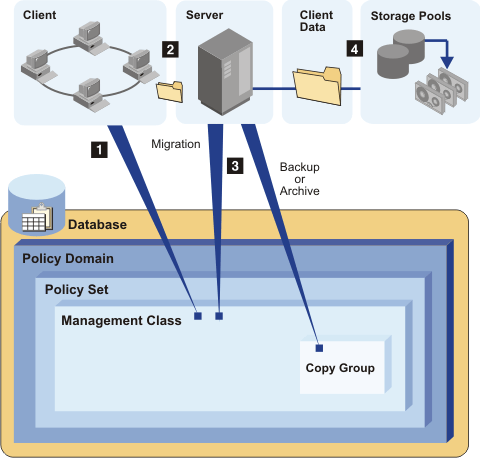Tivoli® Storage Manager policies are rules that determine how the client data is stored and managed. The rules include where the data is initially stored, how many backup versions are kept, how long archive copies are kept, and more.
You can have multiple policies and assign the different policies as needed to specific clients, or files. Policy assigns a location in server storage where data is initially stored. Server storage is divided into storage pools that are groups of storage volumes and can include disk and tape volumes.
When you install Tivoli Storage Manager, you have a default policy that you can use. For details about this default policy, see Reviewing the standard policy. You can modify this policy and define policies.
- Back up and restore
- The backup process copies data from client workstations to server
storage to protect against data-loss. The server retains versions
of a file according to policy, and replaces older versions of the
file with newer versions. The policy includes the number of versions
of files to keep and the retention time for the versions.
A client can restore any version of a file that is kept on the Tivoli Storage Manager server.
- Archive and retrieve
- The archive process copies data from client workstations to the Tivoli Storage Manager server for long-term storage. The process can optionally delete the archived files from the client workstations. The server retains archive copies according to the policy for archive retention time. A client can retrieve an archived copy of a file.
- Instant archive and rapid recovery
- Instant archive is the creation of a complete set of backed-up
files for a client. The set of files is called a backup set, which
is created on the server from the most recently backed-up files.
You can copy a backup set onto compatible portable media, which you can take directly to the client for rapid recovery without the use of a network and communicating with the Tivoli Storage Manager server.
- Migration and recall
- Migration is a function of the Tivoli Storage
Manager for Space Management program.
Migration can free up client storage space by copying files from workstations
to the Tivoli Storage
Manager server.
On the client, the Tivoli Storage
Manager for Space Management program
replaces the original file with a stub file that points to the original
file on the Tivoli Storage
Manager server.
Files can be recalled to the workstations when needed.
The migration process is also called hierarchical storage management (HSM). After migration is configured, the process is transparent to the users. Files are migrated and recalled automatically.
A policy determines when files are considered for automatic migration. On UNIX or Linux systems that support the Tivoli Storage Manager for Space Management program, the policies determine whether files must be backed up to the server before it is migrated. Space management is also integrated with backup. If the file to be backed up is already migrated to server storage, the file is backed up from there.
Figure 1 shows how a policy is part of the Tivoli Storage Manager process for storing client data.

The steps in the process are as follows:
- 1 A client initiates a backup, archive, or migration operation. The file is bound to a management class. The management class is either the default or one specified for the file in the client options file or client options set.
- 2 Based on information in the management class, the client sends the file and file information to the server. The information that is sent depends on the client operation that was performed.
- 3 The server checks the management
class that is bound to the file to determine the destination storage
pool where the file is stored. For backed-up and archived files, the
destination is stored in the backup and archive copy groups within
management classes. For space-managed files, the destination is stored
directly in the management class.
The storage pool can be a group of disk volumes, or tape volumes.
- 4 The server stores the file in the
storage pool that is identified as the storage destination.
The Tivoli Storage Manager server saves information in its database about each file that it backs up, archives, or migrates.
If you set up server storage in a hierarchy, Tivoli Storage Manager can later migrate the file to a storage pool different from the one where the file was initially stored. For example, you might want to set up server storage so that Tivoli Storage Manager migrates files from a disk storage pool to tape volumes in a tape storage pool.
Files remain in the storage pools until they expire and expiration processing occurs, or until they are deleted on the server. A file expires because of criteria that are set in the policy. For example, the criteria include the number of file versions that are allowed and the number of days that have elapsed since a file was deleted from a client-node file system. If data retention protection is activated, an archive object cannot be inadvertently deleted.